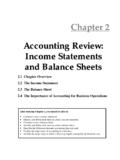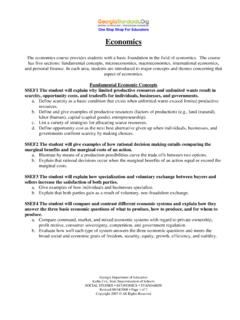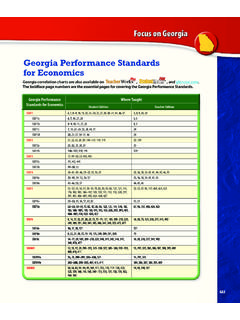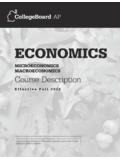Transcription of GEORGIA’S SCRAP TIRE MANAGEMENT PROGRAM
1 georgia S SCRAP TIRE MANAGEMENT PROGRAM :An Assessment Of economic And Environmental ViabilityPrepared forPollution Prevention Assistance DivisionEnvironmental Protection Division, Land Protection BranchGeorgia Department of Natural ResourcesByRonald G. Cummings, Principal InvestigatorKelly M. BrownPeter TerrebonneEnvironmental Policy CenterSchool Of Policy StudiesGeorgia State UniversityAtlanta, GA 30303404-651-1888 Janusz R. MrozekSchool Of EconomicsGeorgia Institute Of TechnologyAtlanta, GA 30332404-894-0353 October 19, 1998-i- georgia S SCRAP TIRE MANAGEMENT PROGRAM :An Assessment Of economic And Environmental ViabilityExecutive SummaryFollowing their survey of present conditions in georgia s SCRAP tire industry and theState s SCRAP Tire MANAGEMENT PROGRAM (the PROGRAM ), the authors of this report identified thefollowing three policy questions which constitute the primary focus of this report.
2 (1) what is a reasonable prognosis for the long-run viability of the PROGRAM sability to achieve the goals of the State Legislature for ensuring that SCRAP tiresgenerated in the State are ..reused or recycled rather than being disposed ?( georgia Code 12-8-21(f) , 1991) (2) are existing state policies adequate?A corollary to this second policy question is: should the existingscrap tire fee be allowed to sunset as provided in the Code? (3) are new state policies and/or programs needed?Referring to (1), all else equal there is a basis for considerable optimism concerningexpectations that the seven million SCRAP tires generated each year in the State will be recycledrather than disposed.
3 Presently, georgia firms process more than twelve million tires (moreaccurately, 12 million passenger tire equivalents ) -- georgia is an importer of SCRAP tires. SCRAP tire processors in georgia presently import tires primarily from Florida, Tennessee, SouthCarolina, and Kentucky. End-users will most likely absorb an additional two million SCRAP tiresand SCRAP tire products within the very near future. Thus, in a state that generates some sevenmillion SCRAP tires each year, processors or direct tdf use of SCRAP tires by cement kilns can beexpected to require more than fourteen million tires. Over a longer period of time -- the next fiveto ten years -- growth in crumb rubber production spurred by ongoing changes in technology andexcess production capacities that presently exist in states like Florida could result in conditionswherein competition for SCRAP tires among processors result in falling tipping fees and arestructuring of the regional SCRAP tire industry (less efficient processors in the region beingforced out of business).
4 It is critically important that one recognize, in terms of the optimism expressed above,that all else may not be equal. The SCRAP tire processing industry in georgia (and other states) isa relatively infant industry. There is a great amount of variability in the quality of chips beingproduced, and there is little in the way of standards for quality. There is also confusion acrosslocal governments in terms of standards related to the use of SCRAP tire products, particularly interms of their use for septic drainage fields. It has been and will likely continue to becharacterized by instability and change as it struggles to establish and maintain its ability to-ii-compete in a market that appears to be persistently expanding in scope.
5 The industry may bedescribed as fragile for a number of reasons set out in the body of this report. Given the uncertainties and vulnerabilities described above as they are relevant for thescrap tire industry, we conclude that the PROGRAM s ability to adequately respond to its legislativemandates will be enhanced by responses to the following recommendations. The reader shouldnote that implementation of the recommendations given below will require funds that wouldlogically come from the Solid Waste Trust Fund. Thus, in offering these recommendations weare tacitly assuming that the SCRAP tire fee is renewed, an issue that is taken up below.
6 Recommendations:* Establish a continuing process for monitoring the SCRAP tire industry inGeorgia and in the Southeast region.* Charge georgia s PROGRAM with the responsibility of preparing an annualreport which describes the state of the system, describes relevant changes thathave the potential for affecting the economic and environmental viability of thesystem, and identifies actions and/or studies required to ameliorate or eliminateeffects from these changes.*Maintain and strengthen local government education and enforcementprograms.*Consider the possibility of establishing state-wide standards for the approveduse of tire chips for septic drainage to policy question (2), with few exceptions we find existing state policiesadequate for achieving the legislature s goals related to SCRAP tire MANAGEMENT .
7 The exceptionsconcern possible new policies discussed in (3) and two changes in the georgia Code as it is nowwritten. The two changes at issue involve the present ban on landfill disposal of whole tires andthe existing sunset provision for the SCRAP tire fee. We have examined arguments for and againstthe maintenance of the present ban on landfill disposal of whole tires. We find that authoritygiven to the Director of the EPD under present law provides the PROGRAM with a great deal offlexibility in responding to short term conditions which might otherwise benefit from removal ofthe ban on landfill disposal of SCRAP tires. We find no compelling case for removing the find what we regard as a strong case for the renewal of the SCRAP tire fee.
8 Basically,this case rests on our findings that the purposes found by the legislature to warrant theestablishment of the fee in 1991 will not sunset by July 1, 2000. Thus, if it made sense toestablish the fee in 1991 it makes sense to renew the fee for another five years. This conclusionis based on the following findings.(i) While the PROGRAM has made great progress in cleaning up SCRAP tire piles that-iii-were known to exist in 1991, new SCRAP tire piles continue to be discovered. Since 1993 newly discovered SCRAP tires in piles have increased at an annual rateof 24%; only recently the EPD discovered two previously unknown piles that maycontain more than one million tires.
9 Most other states have had similarexperiences: the new discovery process can extend over many years.(ii) We emphasized above the uncertainties and vulnerabilities of the industry thataffects the collection and disposition of SCRAP tires in georgia . To ensureaccomplishment of the legislature s long run goals for the PROGRAM it will benecessary for the PROGRAM to expand its planning and enforcement activities (seerecommendations given above). The PROGRAM s focus must move beyond itspresent emphasis on clean-up of SCRAP tire piles to improving its capacity toanticipate emerging problems which could threaten the continued viability of thesystem for collecting/disposing SCRAP tires.
10 Funding for these critical activitiesderive from the SCRAP tire fee.(iii) The need for education and enforcement programs at the level of localgovernments perceived by the legislature in 1991 will also not sunset in the year2000. Indeed, drawing on experiences in other states, they may be expected toincrease in importance in future is well advised to consider experiences -- a recurrence of accumulating SCRAP tirepiles -- in other states that have allowed their SCRAP tire fee to sunset prematurely, , the Statesof Washington, Oregon, and Texas. The authors add the following :* Maintain the existing ban on landfill disposal of SCRAP tires as codified inState Code * Extend the SCRAP tire fee for five to policy question (3), while we found no strong, compelling case for new statelaws, regulations, or programs , we did identify two sets of actions that the State may wish toconsider for possible implementation.



















